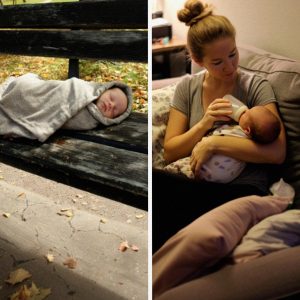Life has a way of splitting itself into “before” and “after” in the quietest, most unexpected moments. For Miranda, it happened on a pre-dawn walk when she found a newborn abandoned on a bus stop bench. Already grieving the loss of her own infant to cancer, she instinctively took the baby home, feeding and comforting him before calling authorities. That small act of care cracked open something inside her, a dormant compassion and sense of purpose, reminding her that even in grief, life still demands attention and presence. The child’s survival and her act of bravery became catalysts for change, proving that sometimes the smallest choices have the greatest impact.
The consequences of Miranda’s kindness extended far beyond the immediate rescue. The child’s grandfather, a man with influence in her workplace, expressed profound gratitude, which unexpectedly reshaped her professional path. From cleaning floors in the pre-dawn hours, she moved into human resources, earned certifications, and helped create a family-friendly workplace that accommodated parents and children. Through dedication and persistence, she established programs that benefited countless families, including the child she had saved and her own son, who thrived alongside the boy. This story illustrates how empathy, when paired with action, can ripple outward, transforming not only individual lives but entire communities.
Similarly, moments of compassion and presence redefine relationships, even after endings. Mina, for instance, had divorced Charles after decades of marriage, yet when he suffered a stroke, she returned to care for him. Through daily acts—reading aloud, tending his hands, filling silence with attention—she forged a new form of connection. They did not remarry; they rebuilt a bond founded on mutual respect and care rather than romantic attachment. This quiet companionship allowed both to reconcile with the past and create something meaningful in its place, even establishing a scholarship for women restarting their lives. Mina’s story emphasizes that closure and transformation often require patience, humility, and attentiveness, and that love can manifest not just in romance but in presence and kindness.
These human experiences mirror the subtler workings of perception and decision-making. Optical illusions, like the “fish or plane” image, reveal that our brains interpret the world in multiple ways, focusing sometimes on details, sometimes on the big picture. Neuroscience shows that both hemispheres of the brain work together in almost all tasks, meaning perception is flexible rather than fixed. Likewise, our interpretations of life events—whether noticing a cry on a cold street or responding to a loved one in need—depend on attention, context, and the choices we make. Just as the mind actively constructs meaning from ambiguous visuals, we shape our lives through perception and conscious action.
Even small, practical acts reflect this principle. Unplugging appliances to prevent phantom energy drain may seem minor, yet it saves money, reduces waste, and prevents potential fire hazards. Attention to seemingly trivial details, like electrical usage, mirrors the broader patterns in life stories: vigilance, care, and responsiveness generate tangible benefits. Whether tending to a neighbor, supporting a family member in crisis, or acting on instinct, these conscious decisions accumulate into lasting change. Every choice, from the mundane to the monumental, reinforces the capacity for mindfulness, foresight, and responsibility.
This lesson also resonates in the story of Mrs. Whitmore, an elderly neighbor helped by a single father and his son, Jack. After assisting her following a fall, he developed a routine of care and companionship that enriched all their lives. Mrs. Whitmore’s final gift—a wooden chest filled with trinkets, letters, and a private jet ticket—was meant not merely as material wealth but as recognition of consistent kindness and attentiveness. While the chest’s monetary value was significant enough to alter their lives, its true meaning lay in the acknowledgment of generosity and human presence. By honoring her legacy through action rather than profit, the father and son internalized the lesson that true inheritance comes not from possessions but from compassion and connection.
Across these narratives, a consistent theme emerges: life’s most profound impacts arise from awareness, responsiveness, and empathy. Miranda’s intervention saved a child and reshaped her career; Mina’s care transformed her relationship with Charles and empowered others through scholarship; the single father’s attentiveness to Mrs. Whitmore guided his son and secured a legacy of generosity; and even everyday actions, like unplugging appliances or observing perception patterns, teach us to notice, respond, and act deliberately. From grief and crisis to joy and routine, these moments illustrate that life’s meaning is co-created through conscious choice and attention to the world around us. Whether in human relationships, professional life, or practical household habits, mindfulness, care, and intentionality can generate change that extends far beyond the immediate moment, rippling into the lives of others and leaving a lasting imprint.





